Data-First Stack as an enabler for Data Products | Issue #7
The Data Product Quantum, the Contractual Landscape, and Right-to-Left Data Modeling
Last week, we published a piece on the Evolution of the Data Stack, and the community resonated well with the story of how the data industry has been interpreting data and the potential way it could effectively manage ever-growing data. Not surprisingly, the Data-First way turned out to be the unmistakable showstopper.
🔶 The Data-First Stack or DFS resonated for one key reason: It is an enabler for Data Products, which the community is increasingly aware of and is progressively creating an industrial demand for.
But to understand how exactly the DFS enables the Data Product construct, we need a couple of brief refreshers.
What is a Data First Stack?
Data-first, as the name suggests, is putting data and data-powered decisions first while de-prioritising everything else either through abstractions or intelligent design architectures.
Current practices, such as the Modern Data Stack, goes by ‘data-last” and focus too much on managing and maintaining data infrastructures. Data and data applications literally become the last priority, creating challenges for data-centric teams, producers, and consumers.
A data-first stack abstracts low-level resource management tasks while not compromising their flexibility to allow data developers the complete freedom to declaratively manage less strategic operations.
A DFS has the following key attributes:
Has high internal quality of unified architecture
Is declaratively manageable with Artefact first, CLI second, and GUI last ideology
Delivers state-of-the-art developer experience
Delivers tangible value within weeks instead of months or years
For a more low-level understanding of each of the above features, refer to the “Defining factors of the Data-First Stack.”
What is a Data Product?
In Data Mesh speak, a Data Product is an architectural quantum, which is the “smallest unit of architecture that can be independently deployed with high functional cohesion and includes all the structural elements required for its function.”
The 3 Data Product components and how a Data-First Stack enables each
To become the independent architectural quantum, a Data Product needs to wrap three structural components:
Code
The code required for data management is far from simple or straightforward. It encompasses data pipelines (ingestion, transformation, and serving), APIs (access, metadata, and metrics), and enforcement (policies, compliances, lineage & provenance).
The reason why the data ecosystem is not as robust as the software ecosystem is that code for data management was never approached from a software development angle. In prevalent data stacks, all these code components are isolated and are unable to talk to each other.
🔑 We do not just suffer from data silos, but there’s a much deeper problem. We also suffer tremendously from data code silos.
A Data First Stack approaches data as software and wraps code to enable object-oriented capabilities such as abstraction, encapsulation, modularity, inheritance, and polymorphism across all the components of the data stack. As an architectural quantum, the code becomes a part of the independent unit that is served as a Data Product.
Becoming data-first within weeks becomes possible through the high internal architectural quality of a DFS that constitutes composable primitive components talking to each other to build finer and more complex data solutions: Unification through Modularisation.
The spiel on code composability is, in fact, endless. More so if we start talking about how data contracts fit into the enforcement narrative, or how federated governance plays out, or how metadata is centrally managed and utilised. Perhaps, I’ll reserve it all for a dedicated piece on the code aspect of data products.
Data & Metadata
Data is undeniably powerless without metadata. The Data Product construct understands this and augments heterogeneous sources to tap into rich metadata. While data can be served in multiple formats, as is usually the need, metadata allows the data product to maintain universal semantics.
🔑 Universal semantics allows the data product to become addressable, discoverable, interoperable, and natively accessible.
Having access to universal metadata, it is possible to identify associations between data assets, surface lineage, provenance, observability metrics, and key relations. It also enables the discovery of latent information, and with open APIs, users can augment and leverage this data programmatically.
With such rich information, data users can throw more light on the data and resurrect it from the limitations of ‘dark data’, which is rich, yet dormant information limited by subpar semantics.
The Data-First Stack enables high-definition metadata through the dual-plane principle. The central control plane has complete visibility across the data ecosystem and is able to oversee metadata flow from heterogenous polyglot sources. The data planes, on the other hand, are isolated instances that are deployed for niche domains, specific data product initiatives, or even for individual use cases.
Having contracts as a key resource of DFS adds more colour. If you think about it fundamentally, a data contract is nothing but metadata + enforcement. Establishing a contract inherently means establishing declarative enforcement. Contracts can either pull metadata from the central plane or be explicitly defined, and once established, they act as a guarantee on the metadata specifications and make change management (one of the biggest challenges) practically seamless.
Infrastructure
The infra is the supporting foundation to enable the code for data products and to ensure that all the nine yards of governance, metadata, and orchestration are declaratively taken care of.
The Data-First Stack is a construct made feasible through a unified architecture ideology laced with contractual handshakes. This unique combination allows the reversal of data accountability to shift it closer to the data source, as is the requirement for a true data product. You’ll soon see how a few scrolls away.
While typically, having dedicated data product owners becomes essential to produce and maintain data products, the infrastructure powering the DFS frees the organisation or data teams from the additional friction of onboarding, training, and maintaining data product developers or data product developer teams.
🔑 Any data developer is a data product developer when armed with a Data-First Stack.
How does the Data-First infrastructure reverse accountability for data?
The declarative ability of DFS is feasible due to flexible abstraction that allows data developers to delegate the process-intensive work and focus on data and data applications.
Interestingly, this declarative ability also allows businesses and domain users to gain control over the data and define it as per the business requirements instead of having to depend on the sub-par domain knowledge of poor centralised data engineering teams who have to crunch information from across multiple domains.
The control goes back through the right-to-left data modeling approach, which is succinctly enabled through DFS. As per the Data Product ideology, accountability for data quality shifts closer to the source of data.
But what is right-to-left data modeling, and how does it shift accountability?
Right-to-left data modeling is the reversal of prevalent paradigms of data modeling, which has been to have central data engineering teams model data based on their partial view of the business landscape, consequently leading to countless iterations and subpar business results.
Thus, the data models produced lack in business context leading to:
Insufficient data that does not serve niche use cases
Multiple iterations of business with data teams to update data models or create new ones
Poor customer experience and long escalation cycle
Right-to-left data modeling is where the business user defines the data models based on use case requirements. This holds even when the data demanded by the model does not exist or has not yet arrived in the org’s data store.
In this reverse approach, business users can further ensure that the data channeled through the data model is of high quality and well-governed through contractual handshakes.
Now, the sole task of the data engineer is to map the available data to the contextually rich data model. This does not require them to struggle with or scrape domain knowledge from vague sources. Imagine a team of less frustrated DEs and nearly happy faces 🌞
This also implies that the use cases on top of the data models are powered by the right data that specifically aligns with the high-value requirements.
What does the outcome look like?
Minimal iterations between data engineers and business users
More concrete and stable data models that adhere to business needs
Shorter path from data to insights, minimal escalations, and fast recovery
To get a more detailed understanding of the reversed data management paradigm, refer to the “proposed right-to-left dataflow.”
How Data Contracts enable a Data Product in a Data-First Stack
Data contracts are the enablers of right-to-left data control, moving data accountability closer to the source and materialising true data products in the process. Without the implementation of Data Contracts, models and the apps in the activation layer cannot channel data that has quality, semantics, and governance guarantees.
Through data contracts, business users define their data expectations based on the use case instead of consuming whatever IT feeds them. This holds even when the data demanded by the data model and the contract do not exist or have not yet arrived in the org’s data store.
Business users can ensure that the data channelled through the data model is of high quality and well-governed through contractual handshakes. The sole task of the data engineer is to map the available data to the contextually rich data model. This does not require them to struggle with or scrape domain knowledge from vague sources. This also implies that the use cases on top of the data models are powered by the right data that specifically aligns with the high-value requirements.
The contractual landscape
Dataview is nothing but a pointer to where the actual physical data is. It acts as a bridge between physical data and contracts. It can reference a table stored in any lakehouse, a topic from Kafka, a snowflake view, a complex query extracting information from multiple sources, etc.
Contract contains strongly typed data expectations like column type, business meaning, quality, and security. Think of them as guidelines to which a Dataview may or may not adhere.
Entity is a logical representation of a business object, mapped by a Dataview adhering to a specific contract with a certain degree of confidence. It also contains information on what can be measured and categorised into dimensions.
Model refers to the semantic business data model that is largely developed based on a thorough knowledge of the industry landscape. The model refers to contracts and dataviews to channel only specific data that adhere to quality, governance, and semantic requirements.
To not become another point of resistance, this landscape allows Data Engineers to independently create dataviews without any dependency on Contracts. Contracts need not be enforced on dataviews. Instead, they may act as guidelines that Data Engineers could choose to adhere to stick to business expectations.
This landscape enables data engineers to start seeing the data contract as an ally and resourceful assistant instead of as an imposing boss. Over time, the value that contracts deliver by reducing the number of requests on the data engineer’s plate leads DE teams to demand contracts and incline towards higher adherence percentages.
🔑 Anytime a data product has to be materialised, a dataview-contract pair needs to be pulled up, where the dataview (not the physical data) adheres to the contract over the required adherence percentage.
Ownership in the contractual landscape
Dataview, Contract, and Entity, each fall under the ownership of different personas. However, no persona is restricted from setting up either of the components. The boundary is loosely defined based on the typical role of three different personas. Here’s what the division of responsibility looks like:
In a DFS that is supported by a unified architecture and dotted with contracts on both production and consumption ends, the Data Developer is intrinsically the Data Product Developer. The need to provision new resources and teams specifically to build and curate data products is dissolved.
Here’s how three data personas interact in the contractual landscape:
The unified foundation of the DFS allows users to catalogue contracts and dataviews intelligently and in a highly discoverable way to ensure that they do not become another unmanageable data asset.
Summary
To summarise, it’ll be best to bring back the data product quantum illustration. Now that we have more context around the details, it will help to connect the dots between the concepts we discussed in this article:
The Data-First Stack
The Data Product Quantum
The Dual Plane Principle
The Unified Architecture
The Contractual Landscape
Right-to-Left Data Modeling
Since its inception, ModernData101 has garnered a select group of Data Leaders and Practitioners among its readership. We’d love to welcome more experts in the field to share their story here and connect with more folks building for better. If you have a story to tell, feel free to email your title and a brief synopsis to the email-ID below:


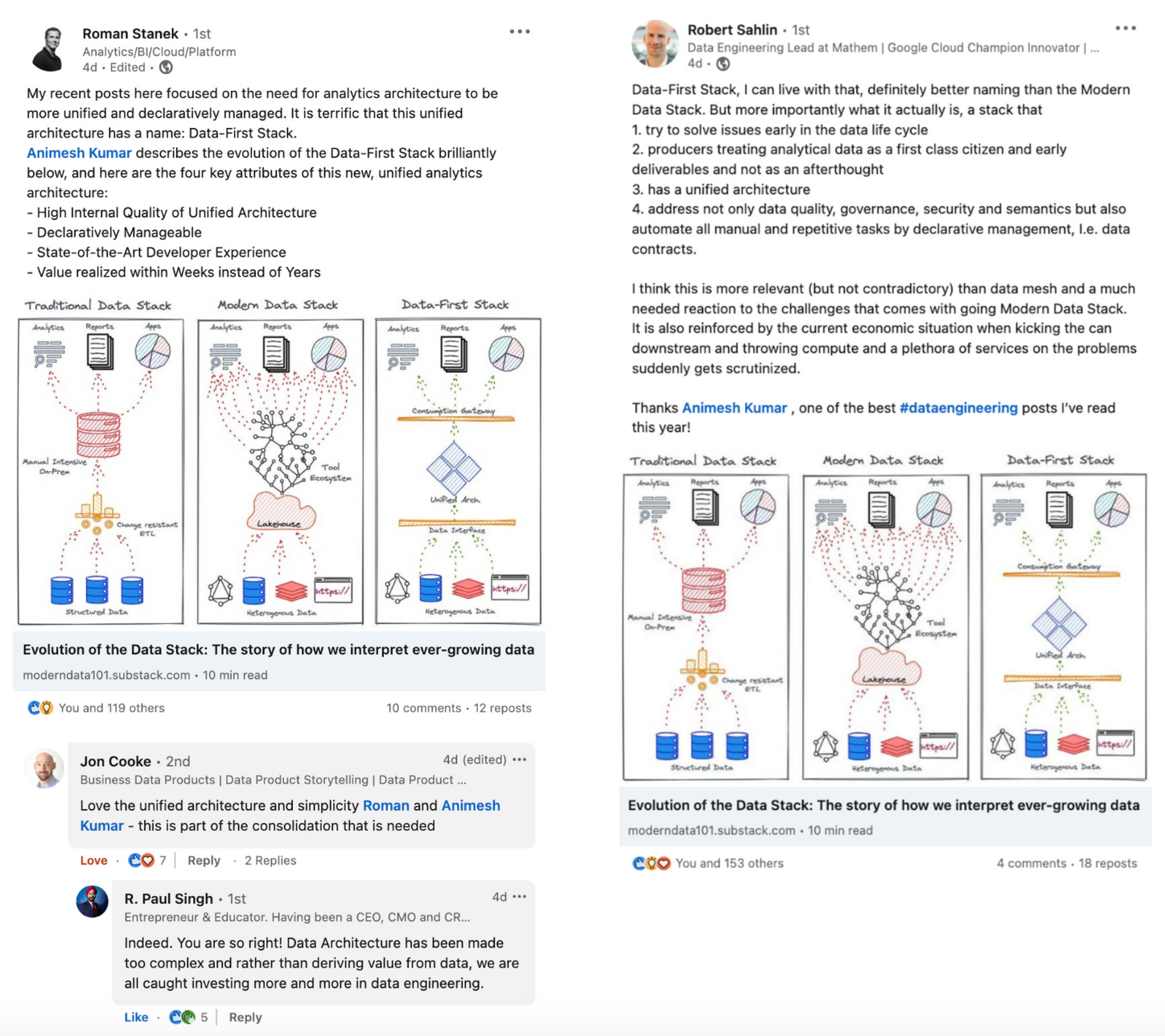

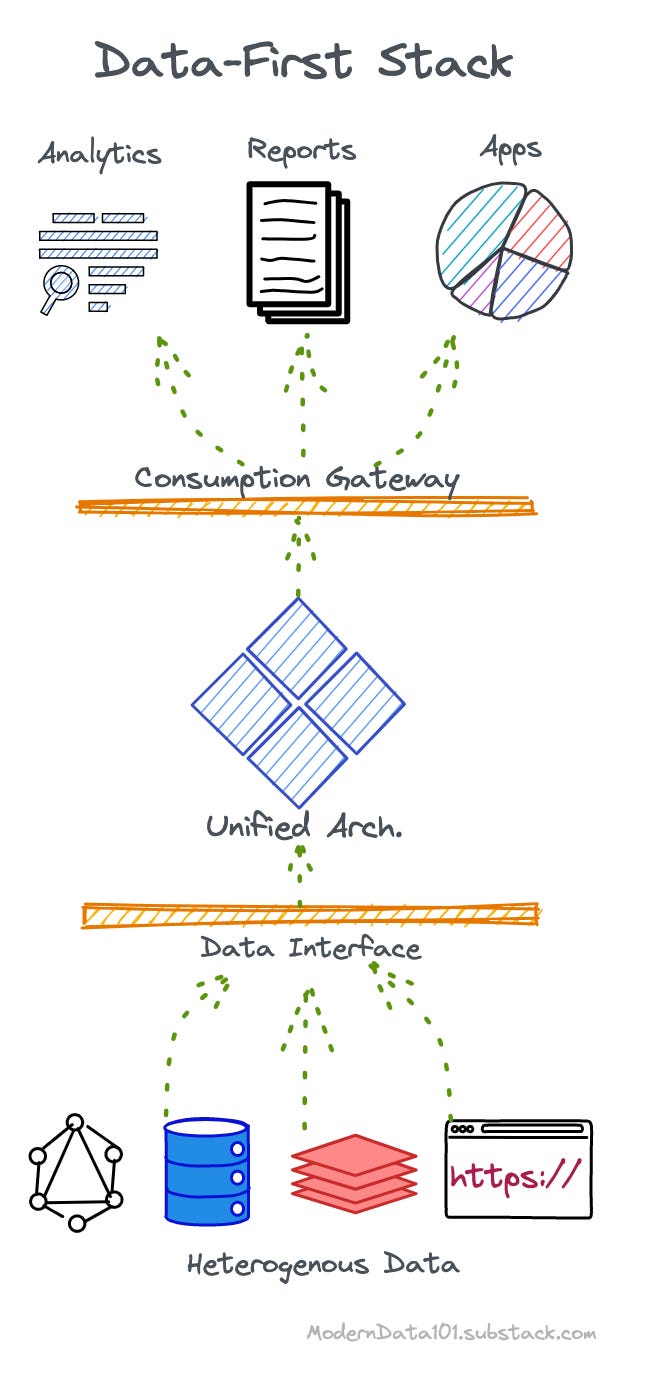
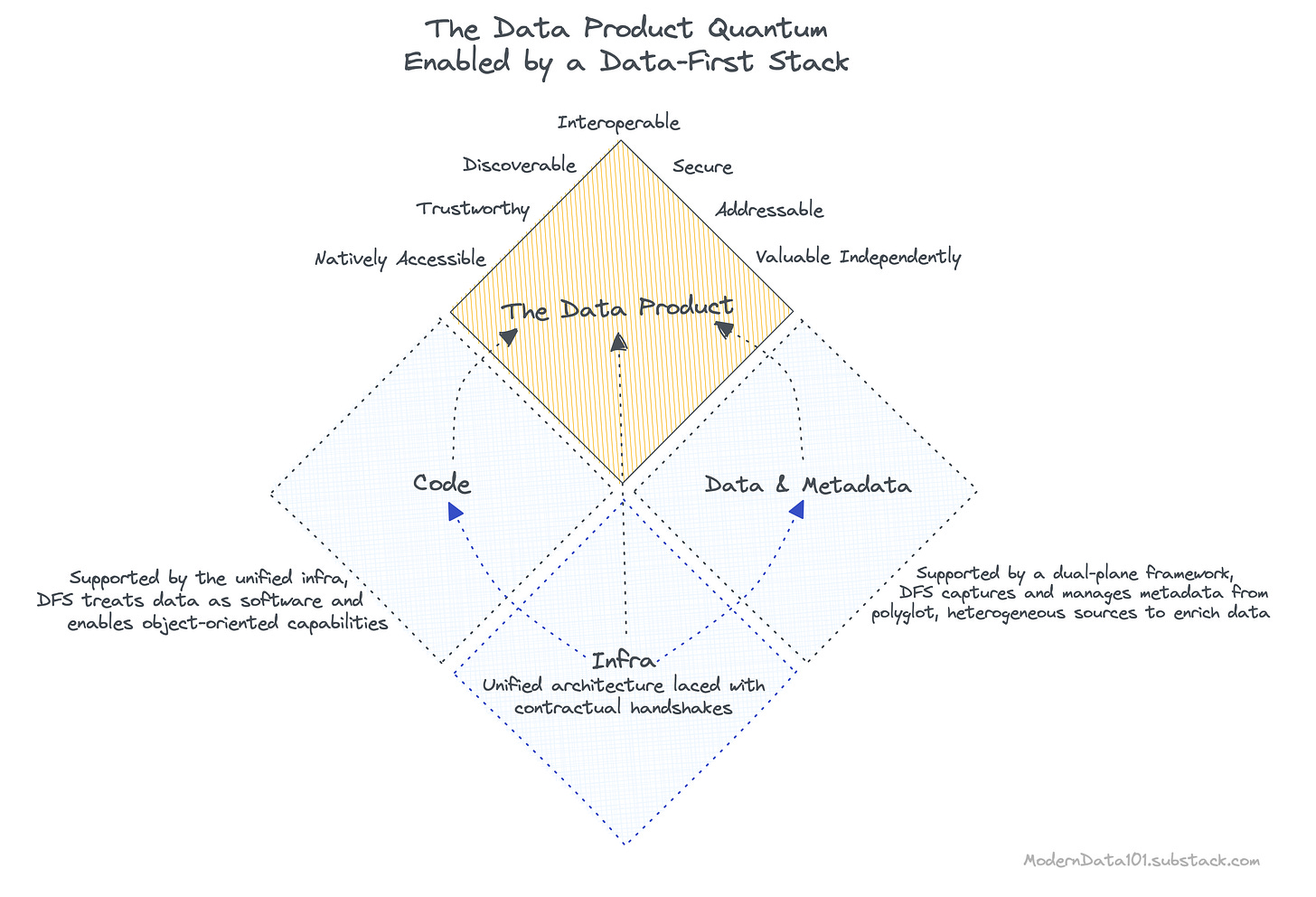
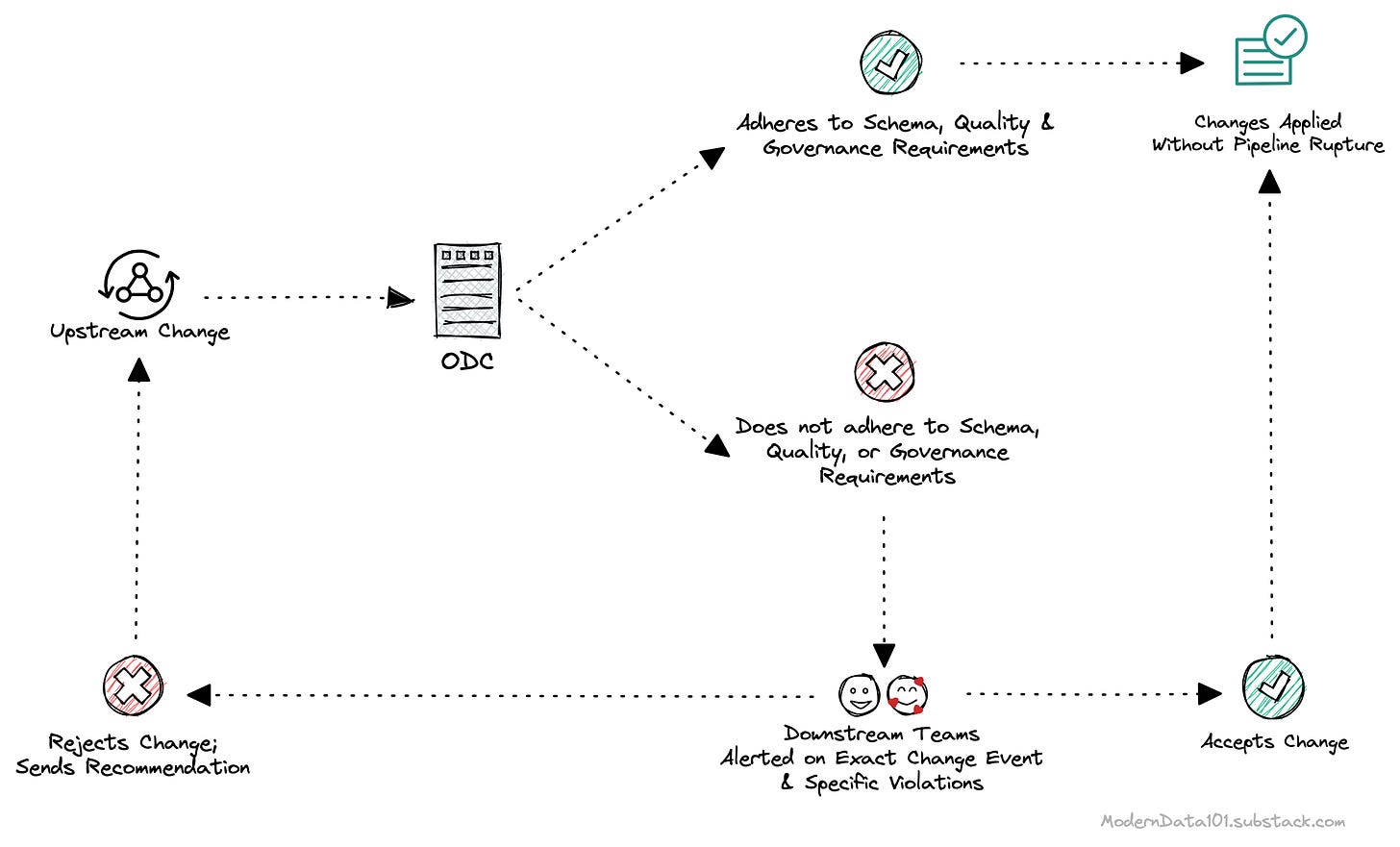



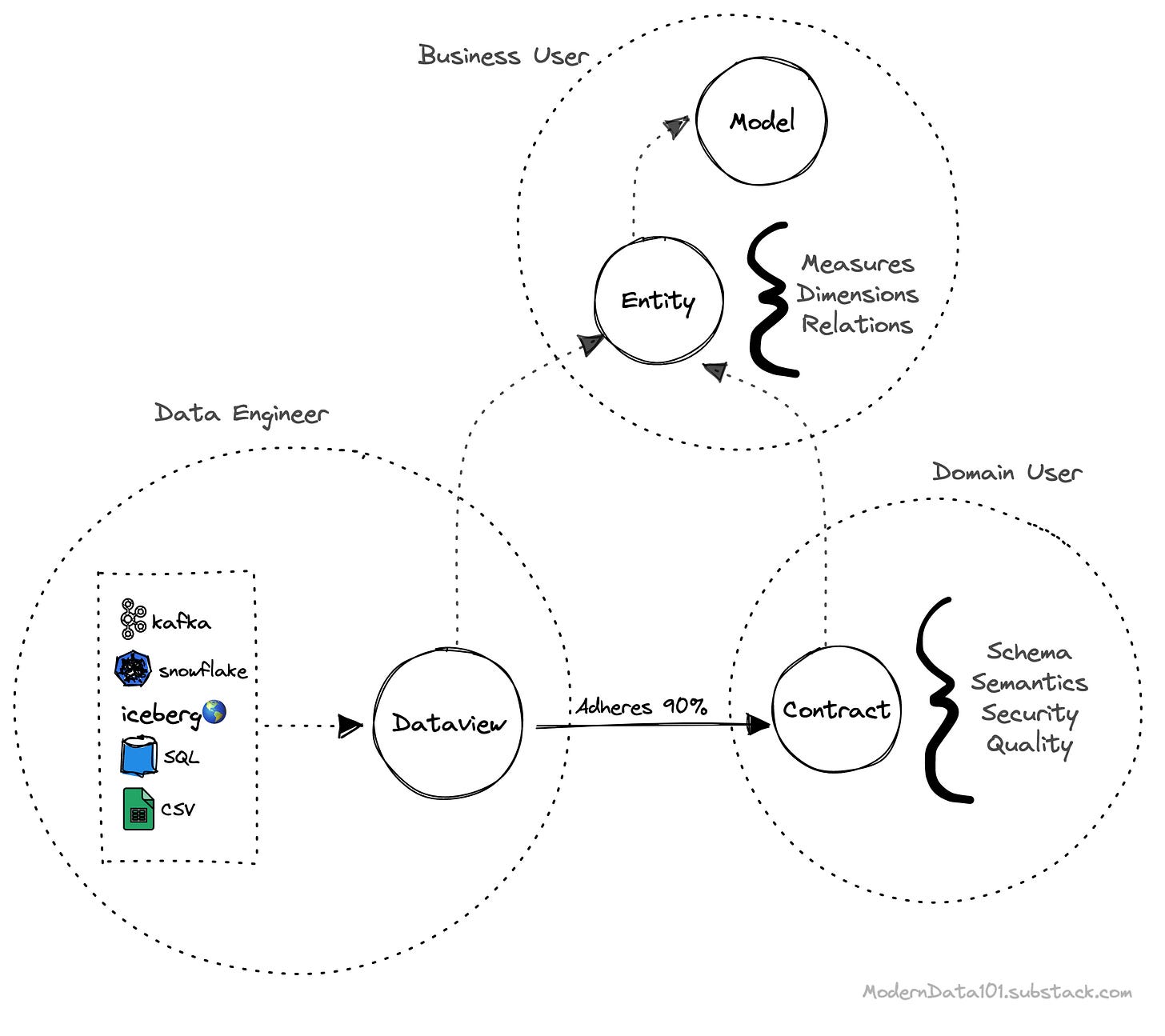



Great ideas about the data-first stack. I still need to process some concepts and think about implementing them. There are technical aspects, but also a lot of organizational and cultural changes that need to be made to succeed.